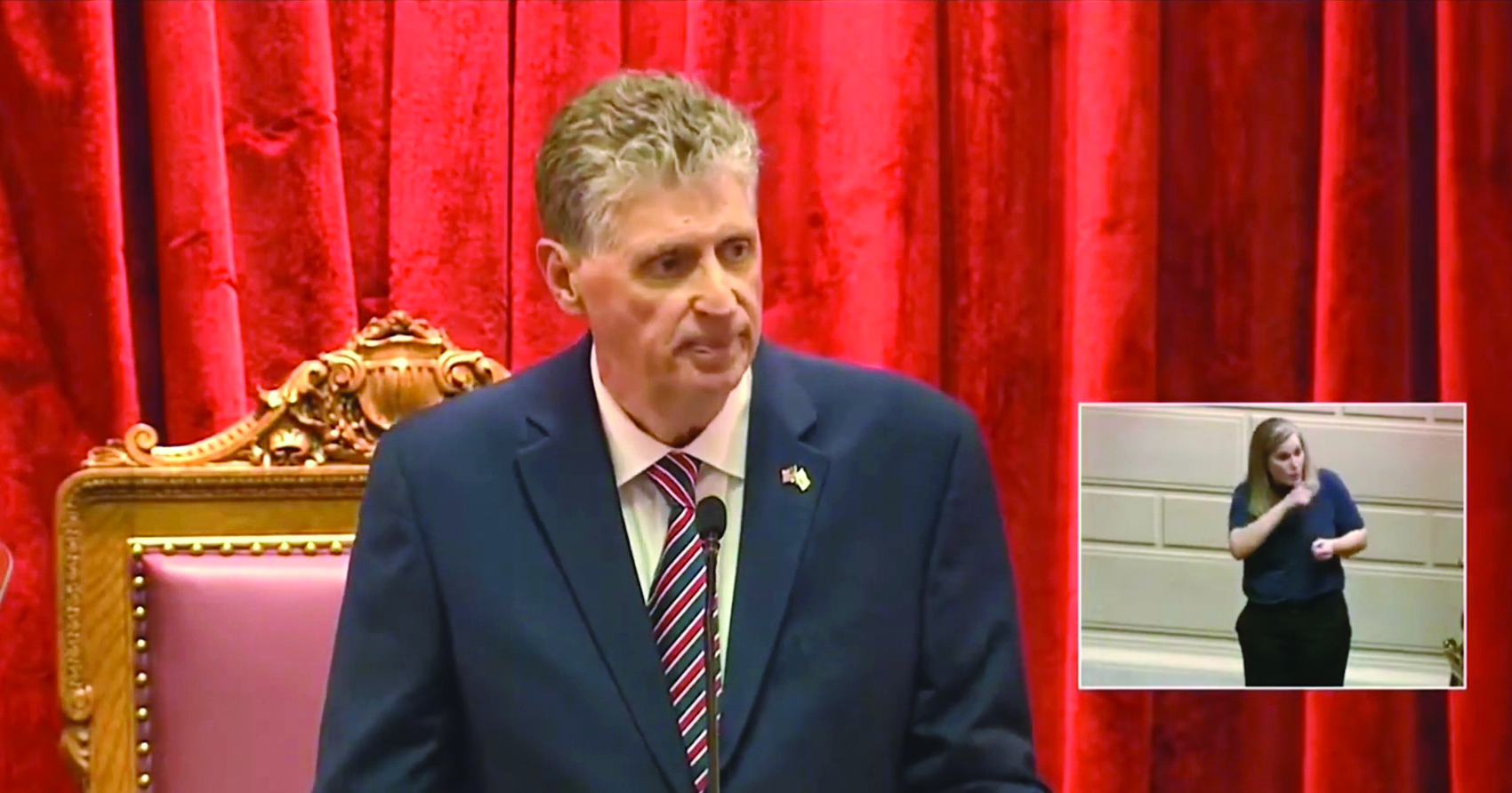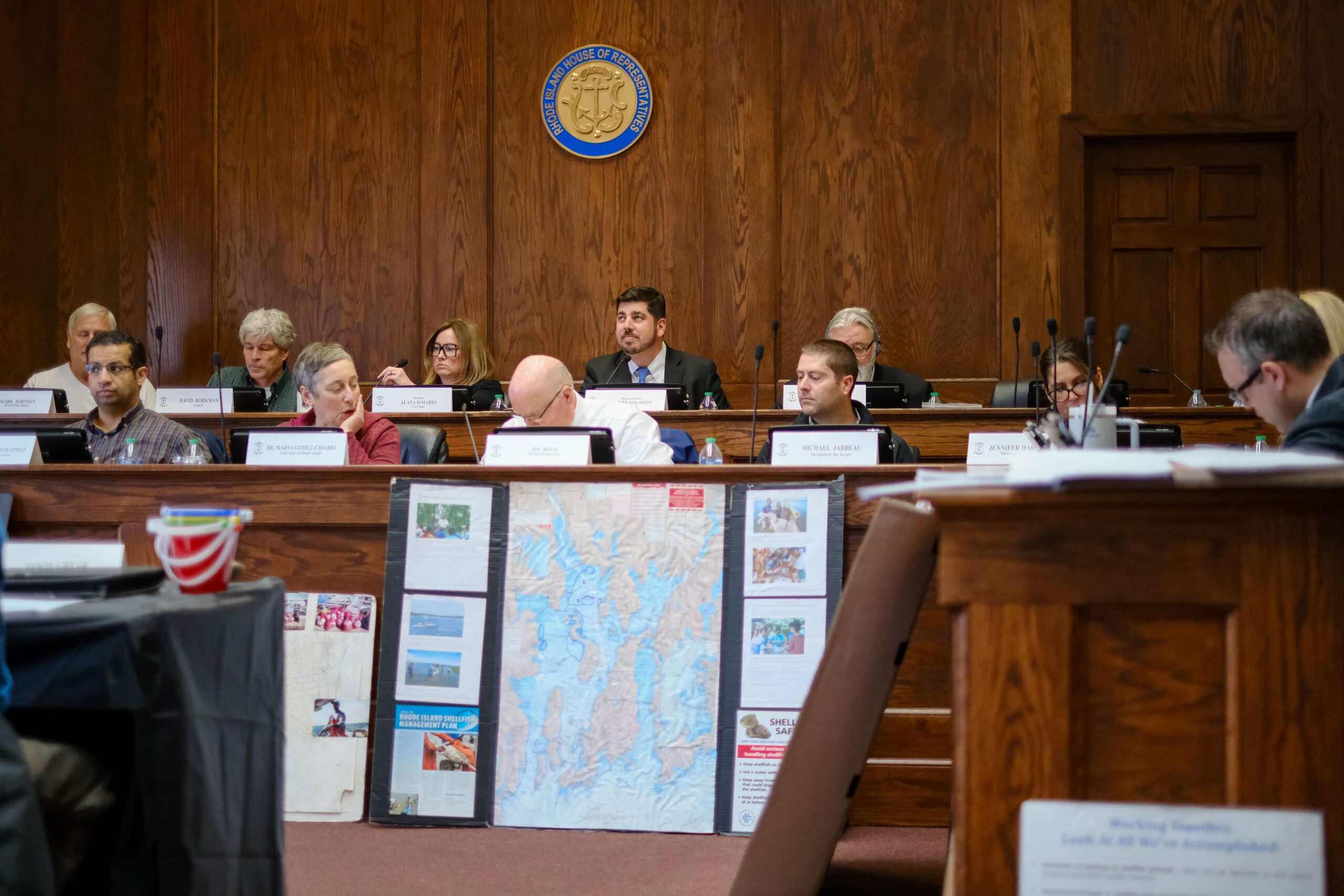‘Right now there’s a lot of DEI: Diversity, Equity, Inclusion. So I want to add A to that: Accessibility. That’s my cause. That’s my drive for law. To make sure that everything is accessible for all people, not just the disabled or deaf, but everybody.’
This story originally was published in the Warwick Beacon, a publication partner of Ocean State Stories.

PROVIDENCE — Governor Dan McKee recently stood at the head of the State House chambers to give an optimistic address to all of Rhode Island and, while it was his speech, he was not the only one who spoke. Alongside the governor in chambers and on television and streaming broadcasts, there was one figure – Jennifer Alleman, the American Sign Language Interpreter.
While she issued no statement herself, her presence was of vital significance to 10,000 Rhode Islanders who speak ASL as their primary language, and rely on her not just to understand the language, but the tone and color of the important speech.
Alleman is a certified interpreter through the Registry of Interpreters for the Deaf. A deaf woman and primary ASL speaker herself, she worked as a team alongside hearing interpreter Heather Anderson, who interpreted the governor’s speech directly to Alleman, from which Alleman interpreted with a greater degree of fluency which only a native speaker of a language can produce. Anderson also provided interpretation for the interview Alleman gave to Rhody Life for this article.
“I’ve always just been fascinated with the application of language in the various cultures,” Alleman told us. “Like, why would you say that and what’s the intention behind it? American mainstream culture with English, there are a lot of implications and a lot of words, implied stuff, but they don’t say it outright. And so how would you interpret that into ASL? The English language is linear and ASL is not… So how can you change English into something more visual and pull out the implied meanings and make it explicit?”
These are questions the polyglot Alleman can consider using any of a number of languages which she speaks, including the sign languages of England, France, Nigeria, and Venezuela. Alleman has traveled to and worked in multiple continents, and has provided interpretation services and advocacy work for deaf immigrants to the United States who may have had no experience with English or ASL. But her life as an interpreter began long before she entered that line of work.
“I grew up in a family that signs,” Alleman said. “My mom can hear but my brother’s deaf and he’s about ten years younger than me. He was about six at the time, learning English. And he already knew ASL, so he was practicing his English. He loved that show called Power Rangers. So he couldn’t read the captions. He would always call me over and say ‘Hey sis, Get over there and interpret.’ And I would read the captions and I would interpret the show for him. And so that’s how originally I started. But at that time, I didn’t know that that was called interpreting. I just thought it was translating.”
It’s worth noting that interpretation and translation have similar, but separate meanings. Translation deals with written language, while interpretation deals with spoken language. That said, the two can easily become obscured when speaking from text or writing from speech.
Interpretation for any language is a sensitive job. Interpreters are expected to be trusted to accurately convey a person’s words to another, an intimate enough task, but they are often made privy to the private details of their lives as well. Sometimes the job requires one to accurately report the words of someone they may seriously disagree with. Interpreters must adhere to a strict code of ethics in order to navigate.
“You have to be impartial, as impartial as you can,” Alleman said. “I mean, we’re not robots, but we just have to maintain unbiased interpretations as much as possible… I’ve faced situations where I feel strongly against something, and in that kind of position I have to choose. Do I want to accept the job or recuse myself?”
“It’s especially difficult when I’m in a situation when I hear things from people who don’t know enough about the deaf community, and that might harm the deaf community,” she continued. “I have to stand there and not say anything, because I’m not on their team. I’m a neutral party, so what am I supposed to do? So I’m interpreting for a person and it’s really their responsibility to speak up, you know, so it’s kind of like a catch 22 sometimes.”
In her role as an interpreter, Alleman doesn’t just work with politicians, though her specialty is in law. She often is asked to help patients and doctors to communicate.
“Right now I have many overlapping layers of confidentiality,” she said. “So for example, if I go into a medical situation and I’m interpreting, and I’m hearing the doctor or the nurse or healthcare workers say something that’s discriminatory, as a lawyer, I want to address it, but I’m not in that role of a lawyer at that moment, so I can’t address it.”
Interpretation in doctors’ offices and hospitals are a vital part of an interpreters’ job. Alleman spoke of what can, and often does occur, when interpreters of not just ASL, but of any language, are not there to interpret for people who don’t speak a given nation’s primary language. Often the role of interpreter is passed to patients’ children, whether or not they’re ready to be privy to the kinds of conversations they’re being asked to interpret. Alleman said “Children don’t have that emotional maturity yet to handle really intense conversations, especially with medical situations.”
In addition to her work as an interpreter, Alleman is also an educator, and advocate for the deaf community. She has degrees from Western Oregon University, and Gallaudet University, the only university in the country which teaches primarily in ASL. She is currently attending law school at Roger Williams University.
“I’m in law school to work with deaf people,” Alleman said. “I want to make sure that they get their access. And right now there’s a lot of DEI: Diversity, Equity, Inclusion. So I want to add A to that: Accessibility. That’s my cause. That’s my drive for law. To make sure that everything is accessible for all people, not just the disabled or deaf, but everybody.
There are, as previously stated, approximately 10,000 people in Rhode Island for which ASL is their primary language, but approximately 213,000 Rhode Islanders are deaf. The Rhode Island Commission on the Deaf and Hard of Hearing estimates 20% of Rhode Islanders have some type of hearing loss. It is worth noting that one does not need to have total hearing loss to be considered deaf. The National Association of the Deaf defines a deaf person as “an individual who has a hearing loss which is so severe that the individual has difficulty in processing linguistic information through hearing, with or without amplification or other assistive technology.”
Assistive technology can come in many forms, and is growing increasingly common with subtitles and automatic captioning technology, but Alleman warns that these cannot and should not be thought of as replacements to true interpretation.
“People think, just broadly, thinking technology can replace an interpreter but really, technology is all in English. It’s all captions or subtitles,” Alleman said. “Some deaf people don’t even know English in the first place.”
She continued: “English is sometimes maybe a second, third, fourth language for some deaf people. So communicating through writing, really, consent can’t happen because there’s a lot of misconceptions.”
These misconceptions often stem from one core misconception of which many hearing people have historically been and are still today guilty: the misconception that sign languages are not real languages. This is a misconception Alleman and many, many other advocates are working to erase.
“I’m working for the deaf community to be viewed as a language minority instead of a disability,” Alleman said.
“ASL is so rich,” she continued. “It’s got its own grammar. It’s got its own structure, syntax. We use our facial expressions. We use our hands, and it’s all instantly right there and it’s not as linear, as I was saying, with English.”
For ASL speakers, Alleman says, “ASL is their understanding. That’s their access.”
For the deaf community, language access is vital, and goes beyond simple speech. “It’s written culture, and community,” Alleman says. “We do go through cultural changes as well. We face various issues, deaf children going through identity, even hearing children who live in a deaf home, because many of them have identity issues too. It’s a cultural thing. It’s not just language.”
Alleman recalled conversations she had had with her own daughters’ teachers. Alleman’s daughter is not deaf, but she remains a product of the culture, a fact which can often come with miscommunications in primarily hearing spaces.
“The first few weeks of school I would get a phone call from the teacher saying ‘Oh, um, I don’t think she’s paying attention. She doesn’t respond when I call on her name,’” Alleman said. “And I’m like, Okay, well, at home, we don’t actually call names. We tap to get attention. Because I don’t speak, I sign and so we rely on contact.
“Somebody else called me and said my daughter is slamming on the desk, because that’s what we do at home. We get each other’s attention through vibrations, and so it kind of startles the teacher, and like, why are you banging on the table? And she’s like, Oh, I’m sorry. I’m really just trying to get attention.”
Access to language in young childhood is a vital part of making sense of the world, something people who hear can easily take for granted. Without ambient language, Alleman pointed out, children can be left in the dark, and that can have lasting consequences.
“A lot of [deaf people] don’t know what they don’t know,” she said. “Because they grew up without that incidental learning, like you have. When you grow up, you’re hearing things on TV commercials, on the radio, or your parents having discussions. So all of that information, you’re hearing it, and you don’t really realize that it’s in you and you have it for the rest of your life.”
Alleman is hopeful that the inclusion of ASL interpreters on broadcasts such as the State of the State, in addition to its vital primary role of providing the deaf community with access to the language of their representatives, will also serve to bring attention to the fullness of ASL language and culture.
“I’m hoping that people will not just see it and say it’s a beautiful language, it’s visual art,” Alleman said, “but as a bonafide language with culture and history behind it. With so many issues and so many frustrations.”
Alleman reminds any who have benefited from the services of an interpreter that that interpreters’ service is not only meant to benefit one side of the language gap. It’s for everyone.
“They think that I work for the deaf people and really, I’m working for the hearing person as well,” Alleman said. “The person who doesn’t sign, I’m interpreting for you as well. And I’m interpreting for the deaf person. And many people think, Oh, we’re getting an interpreter for the deaf person, but really, it’s for both because you don’t know each other’s languages. And that’s what we do. And I think if they looked at it that way, they would see us less as disabled and find it’s really just two worlds coming together.”






